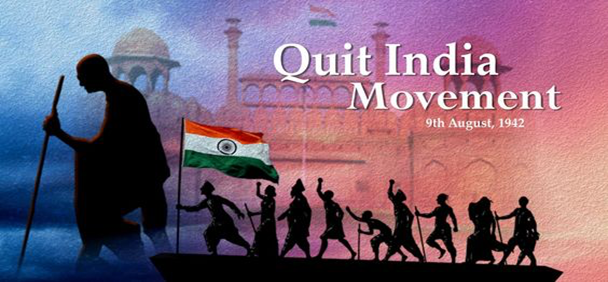80 Years of ‘Quit India Movement’
- Posted By
10Pointer
- Categories
History & Culture
- Published
10th Aug, 2022
-
Context
Recently, India commemorated the 80th anniversary of the Quit India Movement.
- Every year, the day is celebrated by paying tribute to freedom fighters who laid their lives for the country.

About Quit India Movement
- The Quit India Movement is also known as the ‘Bharat Chhodo Andolan’.
- It was launched by Mahatma Gandhi on August 8, 1942, at the Bombay session of the All India Congress Committee (AICC).
- Since the protest was held in August, it also went on to be known as August Kranti or August Movement.
- The ‘Do or Die’ speech by Mahatma Gandhi was etched in the hearts of Indians.
- The movement demanded an end to British rule in India.
Leaders
- Several national leaders like Mahatma Gandhi, Abdul Kalam Azad, Jawaharlal Nehru and Sardar Vallabhbhai Patel were arrested.
- The Congress was declared an unlawful association, leaders were arrested and its offices all over the country were raided and their funds were frozen.
- Aruna Asaf Ali, popularly known as the 'Grand Old Lady' of the Independence Movement, hoisted the National Flag at Mumbai’s Gowalia Tank Maidan.
- This event was followed by an uproar among the people and the emergence of several young leaders such as Ram Manohar Lohia, Jai Prakash Narayan, SM Joshi.
Phases of Quit India Movement
- The Quit India Movement can be viewed in three phases from its inception to end. The phases are as follows-
- First phase: The first phase or the inception of the movement had no violence. It began with civil disobedience, boycotts, strikes that the British Government quickly suppressed.
- Almost all members of the Congress Committee, including Gandhiji, were arrested and kept in Jail till 1945 without any trial.
- Second phase: In its second phase, the movement shifted to the countryside. The second phase of the movement took a violent and aggressive turn.
- Buildings or offices which were the symbol of colonial authority were attacked and distracted.
- Communication systems, railway stations & tracks, telegraph poles and wires were also targeted.
- Third phase: In the last phase of the movement, there was the formation of many independent national or parallel governments in the isolated pockets of the country, such as Ballia, Satara, Tamluk, etc.
Major Causes of Movement
- Involvement of India in World War II: The Quit India Movement was a direct consequence of Britain making India a part of World War II, contrary to the wishes of the Indian Nationalists.
- The failure of the Cripps Mission in April 1942: The British sent Sir Stafford Cripps to India to gain the cooperation of India, which failed because the Cripps Mission offered India not complete freedom but the Dominion Status to India, along with the partition.
- Rising anger and frustration among the people: There was widespread discontent due to the shortage of essential commodities and rising prices of salt, rice, etc., and commandeering of boats in Bengal and Orissa. The Economy also shattered as a result of World War II.
Significance of the movement
- Slogans like “Vande Mataram”, “Jai Hind”, “Inquilab Zindabad” or powerful symbols like charkha, rakhi, salt or khadi acted as a binding force for the masses.
- Despite heavy-handed suppression by the government, the people were unfazed and continued their struggle.
- Even though the government said that independence could be granted only after the end of the war, the movement drove home the point that India could not be governed without the support of the Indians.
- The movement placed the demand for complete independence at the top agenda of the freedom movement.
- Public morale and anti-British sentiment were enhanced.
